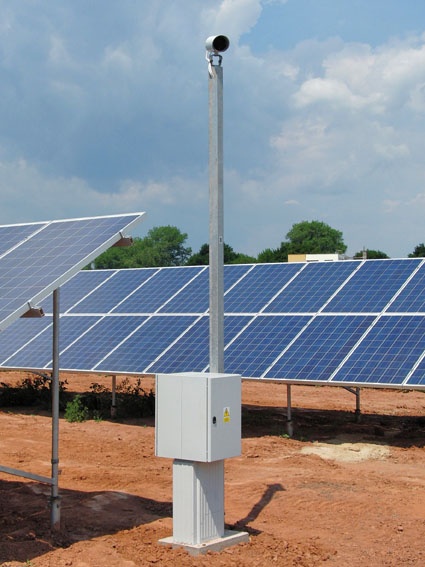CCTV: Addressing Security at Photovoltaic Power Plants
Photovoltaic plants are steadily gaining popularity as an environmentally friendly means to generate power. One related question is how the vast outdoor installations can be protec...


Photovoltaic plants are steadily gaining popularity as an environmentally friendly means to generate power. One related question is how the vast outdoor installations can be protected against theft, unauthorized access and vandalism. Dallmeier has developed an intelligent and efficient surveillance concept which is already in use across a number of photovoltaic plants in the Czech Republic.
Photovoltaic means the direct conversion of sunlight into electrical power through so-called solar cells. A heightened environmental awareness and financial assistance by the government for renewable energy projects has led to the construction of numerous photovoltaic plants. Reliable protection of the usually vast areas against theft or sabotage is not only in the interest of the operators. In the Czech Republic, security systems are also demanded by insurance companies and investors. The requirements for video surveillance and analysis are clearly defined: the system is meant to reliably raise an alarm if an unauthorized person should attempt to access the area. At the same time false alarms triggered, for example, by weather effects or animals should be reduced to a minimum.
Regensburg based CCTV/IP experts Dallmeier collaborated with their local partner, NSN CS, to develop a high-performance video surveillance system for a photovoltaic plant in the south of the Czech Republic. An intelligent video analysis system, namely the DVS 1600, ensures reliable perimeter protection and automatically displays the images to operators in a security room.
However, the solution offers another decisive advantage: the power consumption of the surveillance system has been significantly reduced by using thermal imaging cameras, increasing the efficiency factor of the photovoltaic plant.
Hynek Matocha, Technical Manager at NSN CS, explains: "The operators of the photovoltaic plant had informed themselves thoroughly about CCTV systems in solar plants. Usually, cameras with infra-red lighting are used in order to get usable image material at night. However, the high energy requirements of that concept and the rapid wear and tear of individual components pose a problem. Therefore, our two companies developed a new, more efficient and more reliable surveillance concept."
Low Power Thermal Imaging Cameras
In contrast to other current concepts, the new system uses thermographic cameras instead of cameras with additional infra-red light. The smart idea was devised by Abbas, Dallmeier's local distributor in the Czech Republic. The Flir cameras do not need any light at all and produce high-quality thermal images during daylight as well as in complete darkness, in contrast to other night vision systems which require residual light to produce images. Thus, additional infra-red lighting is no longer necessary and the operating costs of the video system are significantly lower, which means that, despite the higher acquisition costs of the thermal imaging cameras, the investment quickly pays off.
Valid Alarms
The camera images are recorded and intelligently analyzed on a Dallmeier DVS 1600. The Czech photovoltaic plant uses the "Intruder" analysis in order to immediately detect unauthorized access. Hynek Matocha explains the reasons: „The plants are often installed in remote areas where thieves can go unnoticed while dismantling entire modules. Usually the thieves break through the fence or the entrance gates using trucks. Unfortunately sabotage is a problem too. Some people attempt to climb over the fence and then willfully damage the valuable installation." Matocha is more than happy with the results of the new video system. „The system reliably triggers alarms if unauthorized persons attempt to access the premises. At the same time, the number of false alarms is nominal", he says.
During video analysis, the DVS 1600 detects the movement in a given video sequence. The moving objects can be persons and vehicles but also branches, grass, animals or shadows. The detected objects are subjected to a comprehensive validity check in order to minimize the number of false alarms. Decisive criteria for the check are, for instance, the size and the direction of movement of an object.
If an object fits the alarm grid, two important steps are initiated. In a first step, the alarm triggers recording at the DVS 1600. The video server stores for an adjustable time period prior to and after the alarm and associates the alarm with the corresponding image. The whole event is saved in a database and can be investigated at any time. The second step is automatically forwarding the event to the security center where the alarms can be quickly verified and further action initiated if necessary. „We are currently considering the possibility to address intruders via speakers from the security center in order to limit the damage" Matocha says. "That is another interesting option that Dallmeier proposed to us."
Easy Configuration
Hynek Matocha is particularly excited about the easy operation of the recorder: „People always think that installing and configuring a sophisticated video analysis system is a highly complicated job. That is totally different with this new device. It is easy to see that the manufacturers have put special emphasis on an intuitive user concept." A wizard was developed that guides the user step by step through the individual steps of configuration. "All steps are easily understandable and are also explained with online help, so configuration is really simple. The wizard also makes sure that no important steps are forgotten", says Matocha.
Remote Image Transmission
Photovoltaic plants are often built in remote areas where high-bandwidth networks are not usually available. Nevertheless, it must be ensured that the images from the video system are transmitted to the security center reliably and in good quality. Dallmeier has developed a special transmission method called Premote to meet those kinds of requirements. The particular codec is optimized for low bandwidths, enabling fast image transmission even at low bit rates.
In contrast to other low-bandwidth transmission techniques such as Dual Streaming, this system allows not only transmission of live images but also of recorded footage. A multisplit is also possible. Roman Pernica from OP Security, the man responsible for technical operations at the security center, explains: „The performance of Premote is simply convincing. One decisive advantage is the short transmission delay for the control signals to reach the pan/tilt/zoom cameras. Hence, PTZ cameras can also be controlled manually via networks with low bandwidths.
The surveillance concept by Dallmeier has proven itself in practice so well that further projects are already planned. Hynek Matocha explains: "The operator of the photovoltaic plant is highly satisfied with the new surveillance system. We are already in the process of equipping other plants with similar technology."
most read

Is Your Venue Ready for Martyn’s Law?
Martyn’s Law demands stronger security by 2027. Is your venue prepared to protect and respond?

Integrated and Futureproof: Traka’s Next Chapter
Interview with Stefni Oliver on Traka’s Vision for the Future

The Benefits of AI-based Video Surveillance Solutions for Sports Venues
Dallmeier Interview: Artificial intelligence Makes Stadiums Smarter

Five Questions with Intersec Saudi Arabia Exhibition Director Riham Sedik
Intersec Saudi Arabia 2025: Exclusive Insights with Riham Sedik, Exhibition Director








